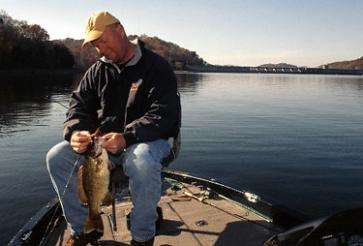
If your smallmouth waters are anything like mine — Dale Hollow Lake on the Tennessee-Kentucky border — they’ve been showing signs of aging for some time. Instead of gray hair or a spare tire around the midsection, bass impoundments (this isn’t true of most natural lakes) show their age with clearing waters, a lack of underwater cover and tough-to-pinpoint bass.
And since most of the impoundments in this country were built between 1945 and 1975, I’ll bet you recognize some of these symptoms. It probably hits the largemouth fishermen harder than it hits us because green fish (largemouth) are more oriented toward shallow water and cover than brown fish (smallmouth). But it affects smallmouth, too.
Some parts of the aging process seem to be good for smallmouth and smallmouth anglers. Clear water is preferred by bronzebacks, so we may be gaining some smallmouth fisheries over time.
The other big factor about aging waters has to do with the loss of cover as it erodes and eventually disappears. That bass have fewer places to hide and less cover to use obviously isn’t good, but we can work it to our advantage if we try hard enough. Whenever I think about a fishing situation, I try to think of how I can turn it to my advantage rather than just think about how it’s going to hurt me.
One way to turn the lack of cover to your advantage is to create your own cover. Man-made brushpiles, tire reefs, stake beds and the like (in lakes where it’s legal to plant them) can be just as good as natural stuff if you put it in the right place.
The right place to put man-made cover is usually an area that was already holding some bass. Remember that your cover won’t likely make a bad spot good. But it just might make a good spot better. So think very carefully before you plant that brushpile, and put it in a place where it will do the most good and help to concentrate the bass.
And once you’ve planted your cover, make sure you know exactly where it is. Lock it into your GPS unit or triangulate it with features on the bank. You don’t want to spend 15 or 20 minutes looking for it the next time you want to catch a bass.
One thing you start to realize really quickly with the bass in older impoundments is that they suspend a lot more than bass in newer waters with more cover. Ordinarily, I’d say that’s a bad thing, but again we can work it to our advantage. The key here is to realize that these suspending fish — if they’re going to bite — are usually relating to something. They’re not just out there suspending in the middle of nowhere for no reason.
And the thing they’re usually relating to is schools of baitfish. In fact, they treat the schools of baitfish almost like they would structure. They even move with the baitfish — especially in the hot summer months.
The key to catching these bass is knowing where they are and knowing how to read your electronics. Sometimes the bass are holding idly by the school of bait, and sometimes they’re attacking them. When you see the big arches in and amongst the school, you can catch a bunch of fish fast. Sometimes you won’t even have to watch your electronics; the bass will tear into the baitfish on the surface, and you can see the action.
A couple of my favorite baits for smallmouths at this time are blade baits like the Silver Buddy and tailspinners like the Little Sparky or Little George. You can cast them a mile — which really helps when you need to make a long cast to reach surfacing bass — and they work at all depths, from just under the surface down to 30 feet or even more.
Don’t let the summertime blues get you down. There are bass out there to be caught, and you can do it if you’re willing to put in the work.
Until next time, if you have any questions or comments, I’d love to hear from you. Please e-mail me atStephen@thesmallmouthguru.com.





